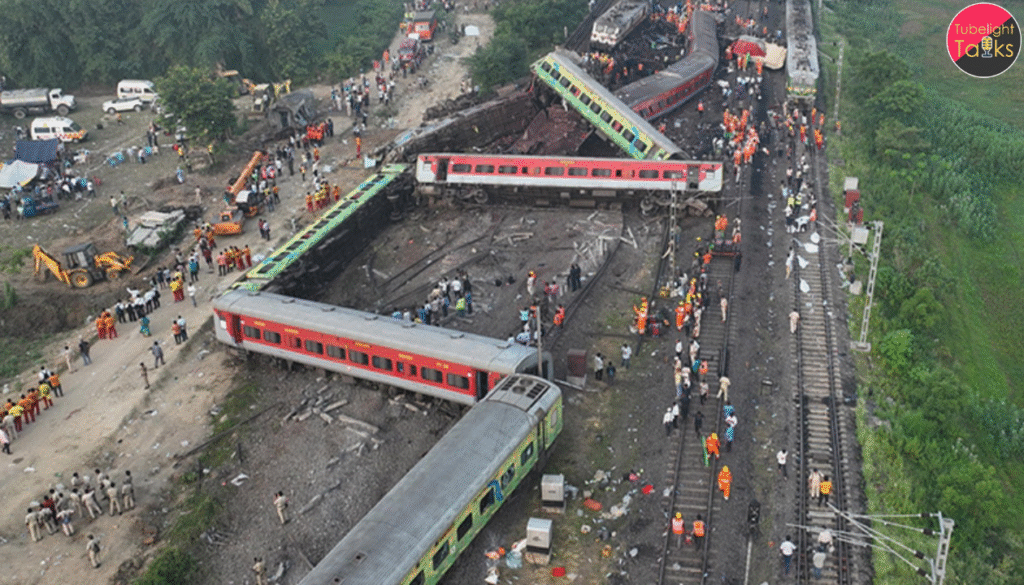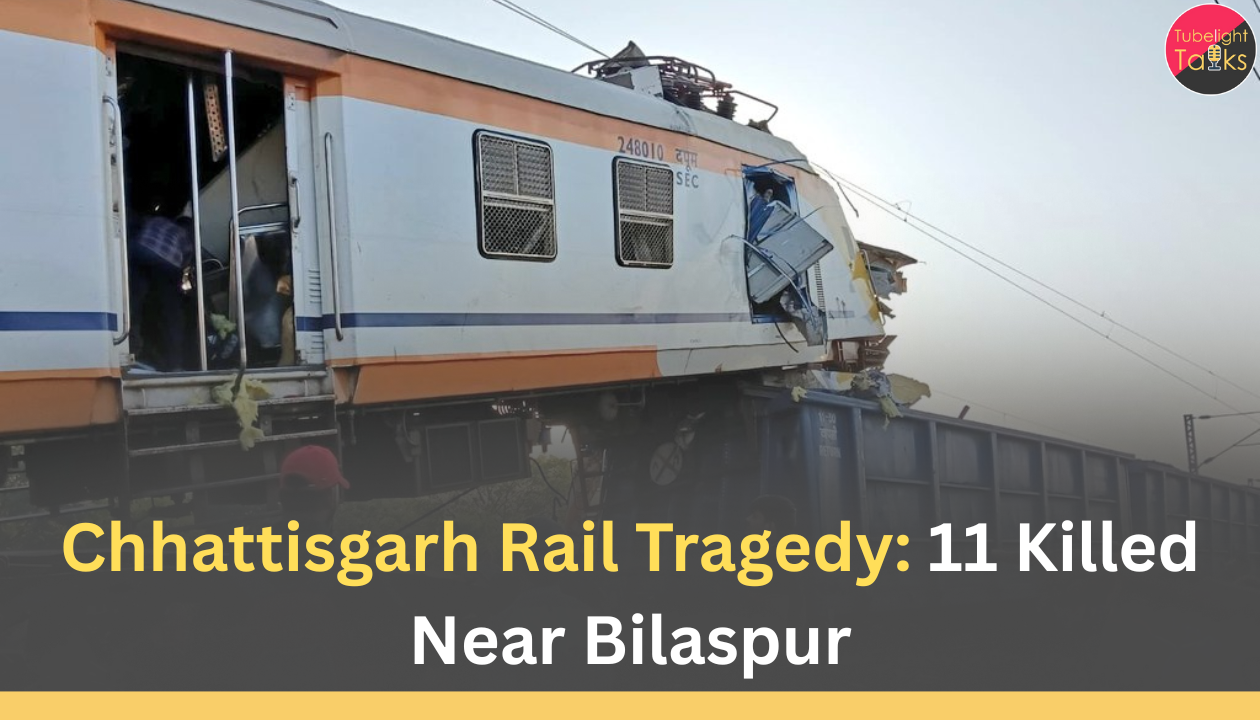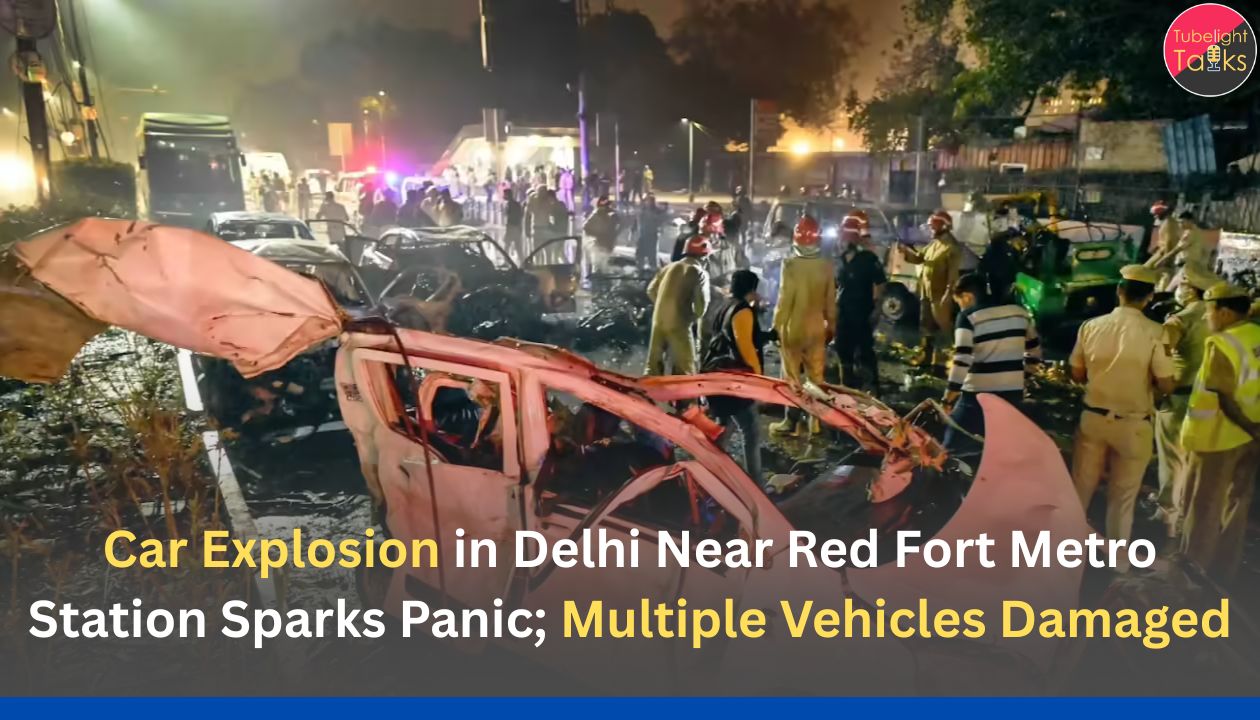Chhattisgarh Rail Tragedy: A routine commuter run turned catastrophic on Tuesday, November 4, 2025, when a Korba–Bilaspur MEMU passenger train rear-ended a stationary goods rake near Bilaspur railway station in Chhattisgarh’s Lalkhadan area. By Wednesday morning, authorities confirmed at least 11 fatalities and roughly 20 injured, after an all-night operation that cut open a mangled coach perched atop a freight wagon. Early findings suggest the passenger train may have “passed a signal at danger” (SPAD). Railways announced ex-gratia relief and opened an inquiry as services through the stretch resumed. Here’s the complete breakdown—timeline, causes under probe, rescue, compensation, and safety reforms.
Where and When the Collision Happened
The collision occurred around 4:00 pm IST on November 4, 2025, between Gatora and Bilaspur stations, in the South East Central Railway (SECR) zone. The passenger service involved was the Korba/Gevra Road–Bilaspur MEMU (a suburban Mainline Electric Multiple Unit) traveling towards Bilaspur, which struck the rear of a stationary goods rake near the Lalkhadan area.
The Immediate Aftermath on the Ground
Eyewitness visuals and officials described the front of the passenger consist mounting the last wagon of the freight train, leaving at least one coach dangerously perched and heavily crushed. Rescue teams used gas cutters through the night to access trapped passengers.
The Human Toll: Casualties and Injuries
By Wednesday (November 5), the confirmed death toll stood at 11, with about 20 injured receiving treatment at local hospitals including CIMS Bilaspur and private facilities. Among the deceased was the locomotive pilot (driver) of the passenger train; his assistant (a woman) was critically injured, according to officials.
Names and Identities
As is standard protocol, authorities have been notifying next of kin and will release identities following due process. (We will update this section if officials publish the full list.) Meanwhile, state leadership has expressed condolences, and Railways has promised accountability.
Why Did It Happen? Early Findings Point to SPAD
A preliminary assessment points to Signal Passed at Danger (SPAD) by the MEMU as the likely trigger—meaning the passenger train allegedly overshot a red signal and struck the stationary goods rake from behind. Multiple outlets cite railway officials and SECR statements indicating SPAD as a working hypothesis; a detailed inquiry has been ordered.
Was Speed a Factor?
One senior railway official quoted in coverage indicated the passenger train may have been traveling in the range of 60–70 km/h at impact. A formal speed determination will come from the statutory probe’s data analysis (including logs and event recorders).
CRS Inquiry and Accountability
Railways has initiated an inquiry at the level of the Commissioner of Railway Safety (CRS) to determine the exact chain of events, test interlocking and signaling logs, and recommend preventive measures. Such probes examine human factors (crew scheduling, fatigue), asset health (rolling stock, brake systems), and system controls (automatic signaling, train protection).
Rescue, Relief, and Reopening of the Line
Rescue operations continued overnight and concluded by around 5:30 am Wednesday. Rail traffic through the section was gradually restored after engineers certified the track and overhead equipment; authorities reported normalisation of movement thereafter.
Ex-Gratia Announcements
Indian Railways and SECR announced ex-gratia compensation: ₹10 lakh to the next of kin of the deceased, ₹5 lakh for grievous injuries, and ₹1 lakh for minor injuries. This was shared via official communications and reiterated by multiple outlets.
Voices from the Site: Passengers as First Responders
Reporting from the scene indicates that fellow passengers and locals were among the first to assist, pulling out victims, offering water, and directing responders to those trapped. Such community response often proves decisive in the “golden hour” following high-impact collisions.
The Bigger Picture: Rail Safety and SPAD in India
India operates one of the world’s busiest rail networks, carrying over 12 million commuters daily. Despite modernisation drives, human error—especially SPAD events—remains a persistent risk. The Bilaspur crash follows the pattern observed in previous high-profile accidents where signaling, protection systems, or human factors were implicated.

What Is SPAD and How Do Systems Prevent It?
“Signal Passed at Danger” occurs when a train passes a stop signal without authority. Mitigations include:
- Automatic Train Protection (ATP)/TCAS (Kavach) to automatically brake trains if crew miss a stop signal.
- Vigilance control to detect crew inattentiveness.
- Crew rosters and fatigue management.
- Periodic rules counseling post-SPAD events.
(Official specifics for this corridor’s protection systems will emerge from the CRS report.) Context from public documentation and industry practice; incident-specific details pending inquiry.
Timeline of the Bilaspur Collision (Nov 4–5, 2025)
- ~4:00 pm: MEMU from Gevra/Korba side towards Bilaspur rear-ends a stationary goods rake near Lalkhadan.
- Evening–Night: NDRF/railway rescue teams work through the night; one coach is cut open.
- Early hours (Nov 5): Death toll reaches 11; ~20 injured being treated.
- ~5:30 am: Rescue concludes; line progressively restored.
Official Statements and Condolences
SECR shared updates on relief, rescue, and compensation on its official X handle, while national media carried Railway Board’s early assessment citing SPAD and announcing a detailed inquiry. State leaders, including Chhattisgarh’s top officials, conveyed condolences to families of victims.
What We Know About the Trains Involved
- Passenger: Korba/Gevra Road–Bilaspur MEMU (suburban commuter service).
- Freight: Stationary goods rake awaiting movement/clearance near Bilaspur.
- Section: Bilaspur–Katni corridor under SECR.
Infrastructure Impact
The collision damaged overhead equipment and signaling around the yard; engineers carried out restoration and safety checks before reopening the line to traffic.
Read Also: India’s Union Cabinet Approves Rs 7,798 Crore for Key Railway Projects and Space Sector Growth
Lessons and Safety Takeaways (For Passengers)
- Adhere to crew instructions during disruptions.
- Know emergency contacts (Railway helplines published by SECR in such events).
- Report hazards (smoke, sparks, unusual noises) to train staff immediately.
- During a crash: Stay low, protect head/neck, avoid running on tracks, follow rescue guidance.
Seeking Safety Outside—and Peace Within
Rail accidents shock communities because they tear the routine out of ordinary life. While infrastructure reforms and accountability are essential, spiritual teachers remind us of inner steadiness amid external crises. Sant Rampal Ji Maharaj’s satsangs speak to living ethically, avoiding intoxication and negligence, and cultivating compassion—virtues that align with a safety culture in any system. His guidance emphasizes true devotion (Satbhakti) and responsible conduct in worldly duties: when people act with clarity and discipline, errors reduce and lives are protected. For those seeking deeper understanding, see the official resources and discourses.
What Families and Commuters Can Do Now
Practical Help, Verified Updates, and Long-Term Safety
- If you’re affected: Use official SECR/Indian Railways updates for helplines and assistance; claim ex-gratia as eligible.
- Donate blood / support victims: Check local hospitals (e.g., CIMS Bilaspur) for needs.
- Demand safety reforms: Encourage accelerated rollout of train protection systems (like ATP/TCAS/Kavach), fatigue-aware rostering, and robust SPAD counseling protocols.
- For inner resilience: If you feel shaken, consider daily reflective practices and, if you wish, explore structured spiritual learning via Sant Rampal Ji Maharaj’s official channels.
FAQs: Chhattisgarh Train Accident
1) What exactly happened near Bilaspur?
A Korba/Gevra Road–Bilaspur MEMU rear-ended a stationary goods rake near the Lalkhadan area around 4:00 pm on November 4, 2025, causing a coach to mount the freight wagon.
2) How many casualties have authorities confirmed?
As of November 5, the toll is at least 11 dead and about 20 injured.
3) What’s the likely cause?
A preliminary probe points to SPAD—the passenger train allegedly overshot a red signal. A statutory CRS inquiry has been ordered.
4) Have trains started running again?
Yes. Rescue concluded early Wednesday (~5:30 am) and services through the site have resumed after safety checks.
5) What compensation has been announced?
Railways/SECR announced ₹10 lakh for next of kin of the deceased, ₹5 lakh for grievous injuries, and ₹1 lakh for minor injuries.
6) Where can I find official updates or guidance?
Follow South East Central Railway’s official communications and verified national outlets carrying Railways’ press notes.







